International Finance
VerifiedAdded on 2023/06/08
|12
|4090
|417
AI Summary
This article provides an overview of international finance and the lessons learned from the Asian crisis of 1997. It also discusses the ways in which multinational enterprises can manage foreign exchange risk.
Contribute Materials
Your contribution can guide someone’s learning journey. Share your
documents today.
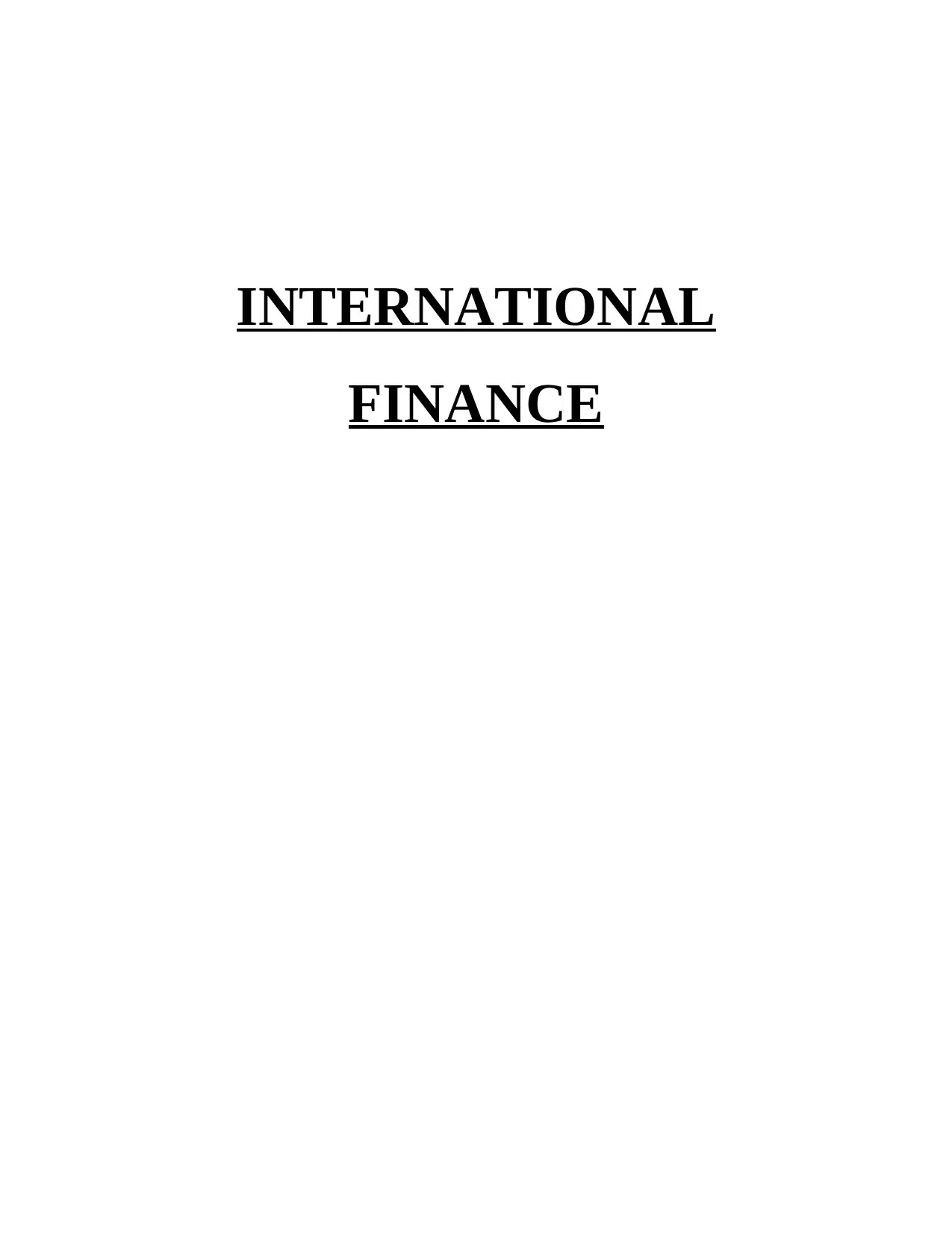
INTERNATIONAL
FINANCE
FINANCE
Secure Best Marks with AI Grader
Need help grading? Try our AI Grader for instant feedback on your assignments.

Table of Contents
INTRODUCTION...........................................................................................................................3
Emerging market policymakers took from the Asian crisis of 1997...........................................3
Ways in which multinational enterprises can manage foreign exchange risk. ...........................6
CONCLUSION..............................................................................................................................10
REFERENCES................................................................................................................................1
INTRODUCTION...........................................................................................................................3
Emerging market policymakers took from the Asian crisis of 1997...........................................3
Ways in which multinational enterprises can manage foreign exchange risk. ...........................6
CONCLUSION..............................................................................................................................10
REFERENCES................................................................................................................................1
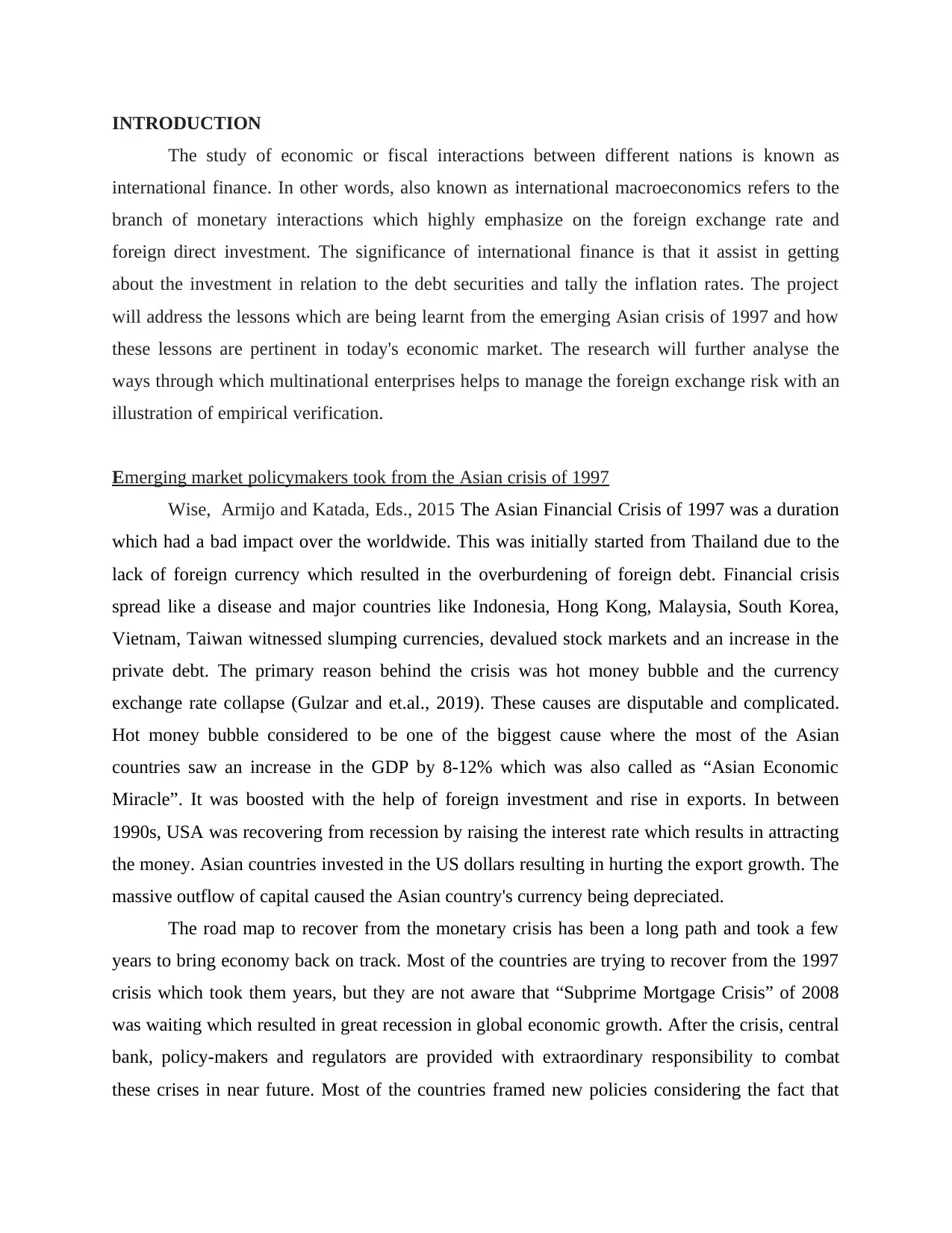
INTRODUCTION
The study of economic or fiscal interactions between different nations is known as
international finance. In other words, also known as international macroeconomics refers to the
branch of monetary interactions which highly emphasize on the foreign exchange rate and
foreign direct investment. The significance of international finance is that it assist in getting
about the investment in relation to the debt securities and tally the inflation rates. The project
will address the lessons which are being learnt from the emerging Asian crisis of 1997 and how
these lessons are pertinent in today's economic market. The research will further analyse the
ways through which multinational enterprises helps to manage the foreign exchange risk with an
illustration of empirical verification.
Emerging market policymakers took from the Asian crisis of 1997
Wise, Armijo and Katada, Eds., 2015 The Asian Financial Crisis of 1997 was a duration
which had a bad impact over the worldwide. This was initially started from Thailand due to the
lack of foreign currency which resulted in the overburdening of foreign debt. Financial crisis
spread like a disease and major countries like Indonesia, Hong Kong, Malaysia, South Korea,
Vietnam, Taiwan witnessed slumping currencies, devalued stock markets and an increase in the
private debt. The primary reason behind the crisis was hot money bubble and the currency
exchange rate collapse (Gulzar and et.al., 2019). These causes are disputable and complicated.
Hot money bubble considered to be one of the biggest cause where the most of the Asian
countries saw an increase in the GDP by 8-12% which was also called as “Asian Economic
Miracle”. It was boosted with the help of foreign investment and rise in exports. In between
1990s, USA was recovering from recession by raising the interest rate which results in attracting
the money. Asian countries invested in the US dollars resulting in hurting the export growth. The
massive outflow of capital caused the Asian country's currency being depreciated.
The road map to recover from the monetary crisis has been a long path and took a few
years to bring economy back on track. Most of the countries are trying to recover from the 1997
crisis which took them years, but they are not aware that “Subprime Mortgage Crisis” of 2008
was waiting which resulted in great recession in global economic growth. After the crisis, central
bank, policy-makers and regulators are provided with extraordinary responsibility to combat
these crises in near future. Most of the countries framed new policies considering the fact that
The study of economic or fiscal interactions between different nations is known as
international finance. In other words, also known as international macroeconomics refers to the
branch of monetary interactions which highly emphasize on the foreign exchange rate and
foreign direct investment. The significance of international finance is that it assist in getting
about the investment in relation to the debt securities and tally the inflation rates. The project
will address the lessons which are being learnt from the emerging Asian crisis of 1997 and how
these lessons are pertinent in today's economic market. The research will further analyse the
ways through which multinational enterprises helps to manage the foreign exchange risk with an
illustration of empirical verification.
Emerging market policymakers took from the Asian crisis of 1997
Wise, Armijo and Katada, Eds., 2015 The Asian Financial Crisis of 1997 was a duration
which had a bad impact over the worldwide. This was initially started from Thailand due to the
lack of foreign currency which resulted in the overburdening of foreign debt. Financial crisis
spread like a disease and major countries like Indonesia, Hong Kong, Malaysia, South Korea,
Vietnam, Taiwan witnessed slumping currencies, devalued stock markets and an increase in the
private debt. The primary reason behind the crisis was hot money bubble and the currency
exchange rate collapse (Gulzar and et.al., 2019). These causes are disputable and complicated.
Hot money bubble considered to be one of the biggest cause where the most of the Asian
countries saw an increase in the GDP by 8-12% which was also called as “Asian Economic
Miracle”. It was boosted with the help of foreign investment and rise in exports. In between
1990s, USA was recovering from recession by raising the interest rate which results in attracting
the money. Asian countries invested in the US dollars resulting in hurting the export growth. The
massive outflow of capital caused the Asian country's currency being depreciated.
The road map to recover from the monetary crisis has been a long path and took a few
years to bring economy back on track. Most of the countries are trying to recover from the 1997
crisis which took them years, but they are not aware that “Subprime Mortgage Crisis” of 2008
was waiting which resulted in great recession in global economic growth. After the crisis, central
bank, policy-makers and regulators are provided with extraordinary responsibility to combat
these crises in near future. Most of the countries framed new policies considering the fact that
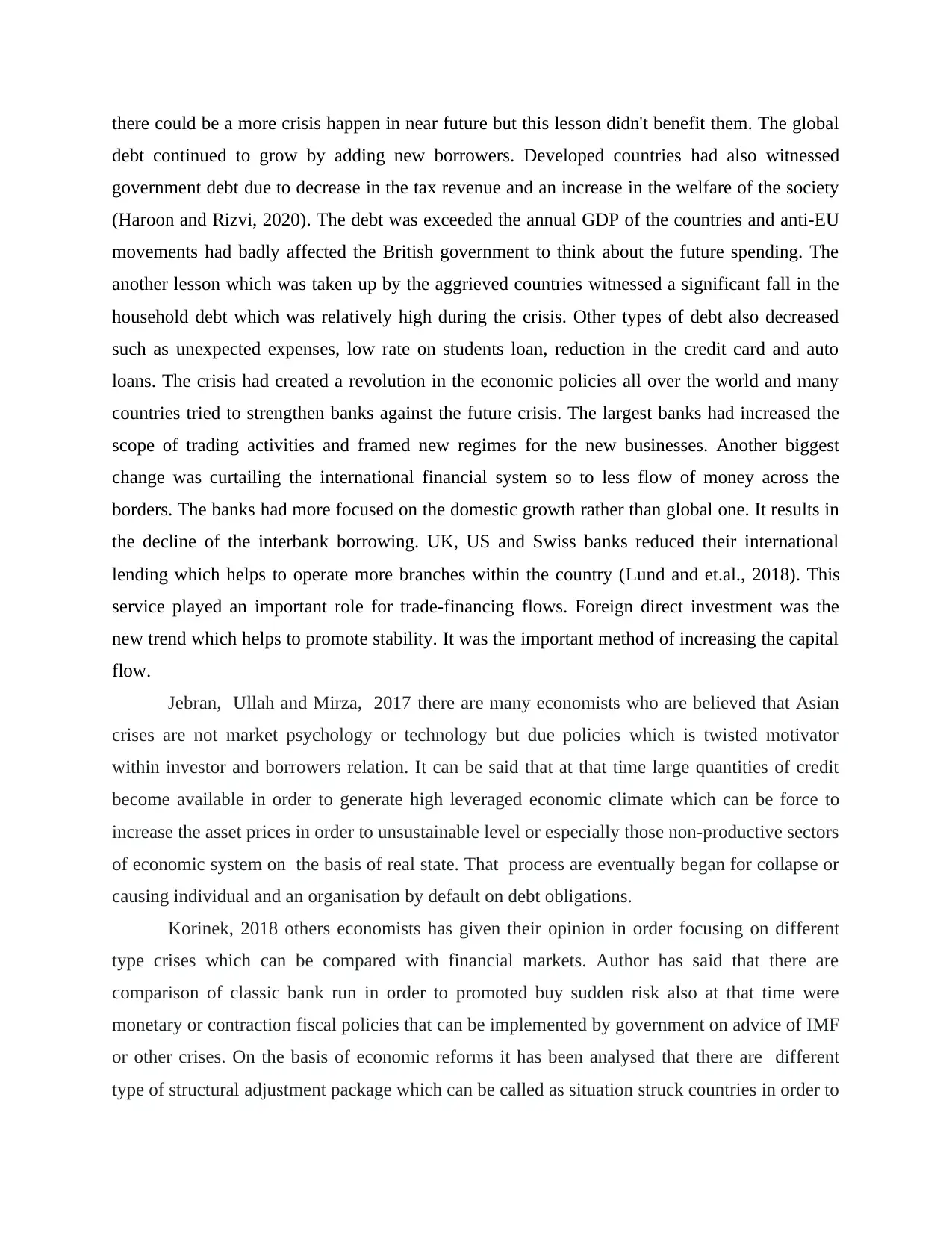
there could be a more crisis happen in near future but this lesson didn't benefit them. The global
debt continued to grow by adding new borrowers. Developed countries had also witnessed
government debt due to decrease in the tax revenue and an increase in the welfare of the society
(Haroon and Rizvi, 2020). The debt was exceeded the annual GDP of the countries and anti-EU
movements had badly affected the British government to think about the future spending. The
another lesson which was taken up by the aggrieved countries witnessed a significant fall in the
household debt which was relatively high during the crisis. Other types of debt also decreased
such as unexpected expenses, low rate on students loan, reduction in the credit card and auto
loans. The crisis had created a revolution in the economic policies all over the world and many
countries tried to strengthen banks against the future crisis. The largest banks had increased the
scope of trading activities and framed new regimes for the new businesses. Another biggest
change was curtailing the international financial system so to less flow of money across the
borders. The banks had more focused on the domestic growth rather than global one. It results in
the decline of the interbank borrowing. UK, US and Swiss banks reduced their international
lending which helps to operate more branches within the country (Lund and et.al., 2018). This
service played an important role for trade-financing flows. Foreign direct investment was the
new trend which helps to promote stability. It was the important method of increasing the capital
flow.
Jebran, Ullah and Mirza, 2017 there are many economists who are believed that Asian
crises are not market psychology or technology but due policies which is twisted motivator
within investor and borrowers relation. It can be said that at that time large quantities of credit
become available in order to generate high leveraged economic climate which can be force to
increase the asset prices in order to unsustainable level or especially those non-productive sectors
of economic system on the basis of real state. That process are eventually began for collapse or
causing individual and an organisation by default on debt obligations.
Korinek, 2018 others economists has given their opinion in order focusing on different
type crises which can be compared with financial markets. Author has said that there are
comparison of classic bank run in order to promoted buy sudden risk also at that time were
monetary or contraction fiscal policies that can be implemented by government on advice of IMF
or other crises. On the basis of economic reforms it has been analysed that there are different
type of structural adjustment package which can be called as situation struck countries in order to
debt continued to grow by adding new borrowers. Developed countries had also witnessed
government debt due to decrease in the tax revenue and an increase in the welfare of the society
(Haroon and Rizvi, 2020). The debt was exceeded the annual GDP of the countries and anti-EU
movements had badly affected the British government to think about the future spending. The
another lesson which was taken up by the aggrieved countries witnessed a significant fall in the
household debt which was relatively high during the crisis. Other types of debt also decreased
such as unexpected expenses, low rate on students loan, reduction in the credit card and auto
loans. The crisis had created a revolution in the economic policies all over the world and many
countries tried to strengthen banks against the future crisis. The largest banks had increased the
scope of trading activities and framed new regimes for the new businesses. Another biggest
change was curtailing the international financial system so to less flow of money across the
borders. The banks had more focused on the domestic growth rather than global one. It results in
the decline of the interbank borrowing. UK, US and Swiss banks reduced their international
lending which helps to operate more branches within the country (Lund and et.al., 2018). This
service played an important role for trade-financing flows. Foreign direct investment was the
new trend which helps to promote stability. It was the important method of increasing the capital
flow.
Jebran, Ullah and Mirza, 2017 there are many economists who are believed that Asian
crises are not market psychology or technology but due policies which is twisted motivator
within investor and borrowers relation. It can be said that at that time large quantities of credit
become available in order to generate high leveraged economic climate which can be force to
increase the asset prices in order to unsustainable level or especially those non-productive sectors
of economic system on the basis of real state. That process are eventually began for collapse or
causing individual and an organisation by default on debt obligations.
Korinek, 2018 others economists has given their opinion in order focusing on different
type crises which can be compared with financial markets. Author has said that there are
comparison of classic bank run in order to promoted buy sudden risk also at that time were
monetary or contraction fiscal policies that can be implemented by government on advice of IMF
or other crises. On the basis of economic reforms it has been analysed that there are different
type of structural adjustment package which can be called as situation struck countries in order to
Secure Best Marks with AI Grader
Need help grading? Try our AI Grader for instant feedback on your assignments.
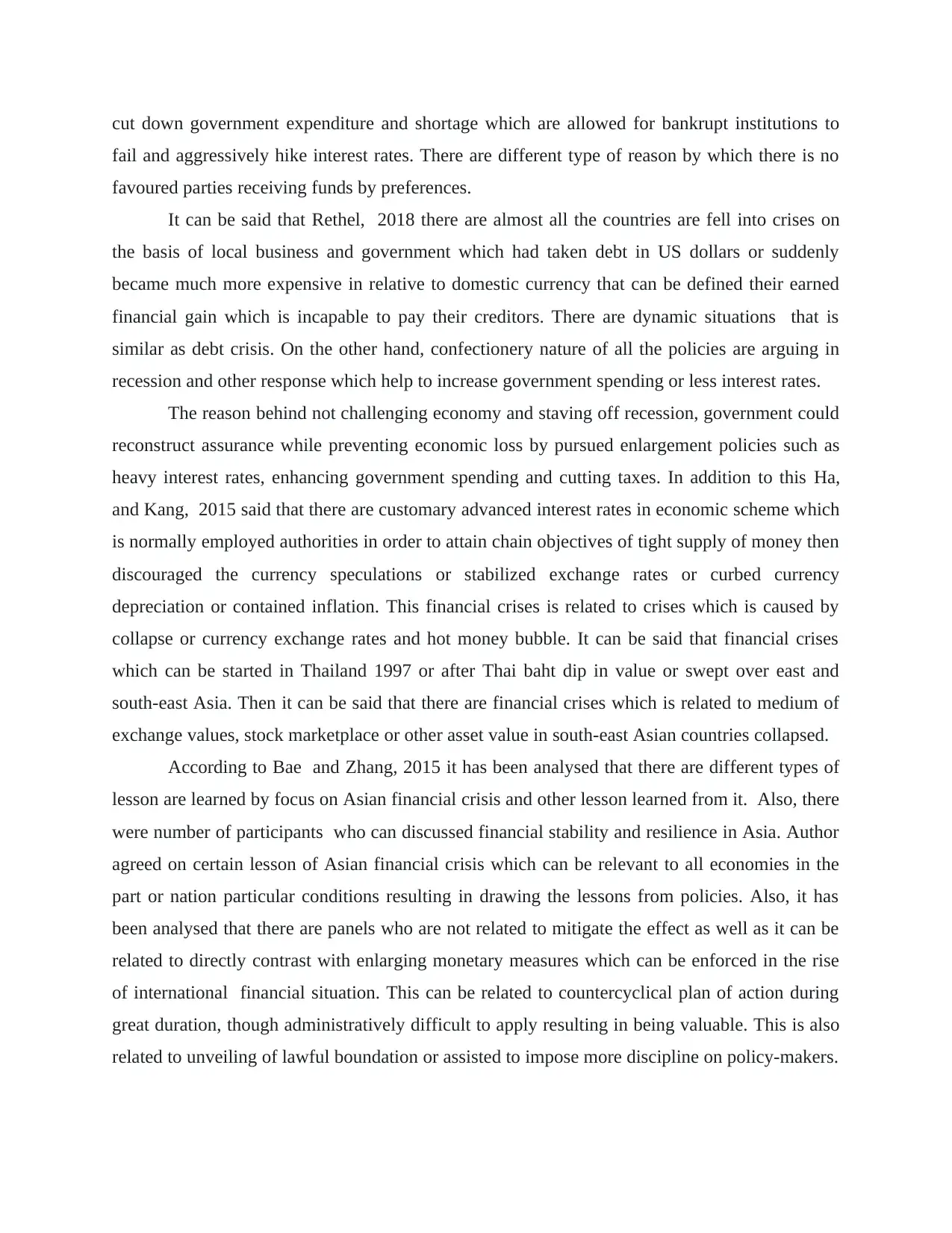
cut down government expenditure and shortage which are allowed for bankrupt institutions to
fail and aggressively hike interest rates. There are different type of reason by which there is no
favoured parties receiving funds by preferences.
It can be said that Rethel, 2018 there are almost all the countries are fell into crises on
the basis of local business and government which had taken debt in US dollars or suddenly
became much more expensive in relative to domestic currency that can be defined their earned
financial gain which is incapable to pay their creditors. There are dynamic situations that is
similar as debt crisis. On the other hand, confectionery nature of all the policies are arguing in
recession and other response which help to increase government spending or less interest rates.
The reason behind not challenging economy and staving off recession, government could
reconstruct assurance while preventing economic loss by pursued enlargement policies such as
heavy interest rates, enhancing government spending and cutting taxes. In addition to this Ha,
and Kang, 2015 said that there are customary advanced interest rates in economic scheme which
is normally employed authorities in order to attain chain objectives of tight supply of money then
discouraged the currency speculations or stabilized exchange rates or curbed currency
depreciation or contained inflation. This financial crises is related to crises which is caused by
collapse or currency exchange rates and hot money bubble. It can be said that financial crises
which can be started in Thailand 1997 or after Thai baht dip in value or swept over east and
south-east Asia. Then it can be said that there are financial crises which is related to medium of
exchange values, stock marketplace or other asset value in south-east Asian countries collapsed.
According to Bae and Zhang, 2015 it has been analysed that there are different types of
lesson are learned by focus on Asian financial crisis and other lesson learned from it. Also, there
were number of participants who can discussed financial stability and resilience in Asia. Author
agreed on certain lesson of Asian financial crisis which can be relevant to all economies in the
part or nation particular conditions resulting in drawing the lessons from policies. Also, it has
been analysed that there are panels who are not related to mitigate the effect as well as it can be
related to directly contrast with enlarging monetary measures which can be enforced in the rise
of international financial situation. This can be related to countercyclical plan of action during
great duration, though administratively difficult to apply resulting in being valuable. This is also
related to unveiling of lawful boundation or assisted to impose more discipline on policy-makers.
fail and aggressively hike interest rates. There are different type of reason by which there is no
favoured parties receiving funds by preferences.
It can be said that Rethel, 2018 there are almost all the countries are fell into crises on
the basis of local business and government which had taken debt in US dollars or suddenly
became much more expensive in relative to domestic currency that can be defined their earned
financial gain which is incapable to pay their creditors. There are dynamic situations that is
similar as debt crisis. On the other hand, confectionery nature of all the policies are arguing in
recession and other response which help to increase government spending or less interest rates.
The reason behind not challenging economy and staving off recession, government could
reconstruct assurance while preventing economic loss by pursued enlargement policies such as
heavy interest rates, enhancing government spending and cutting taxes. In addition to this Ha,
and Kang, 2015 said that there are customary advanced interest rates in economic scheme which
is normally employed authorities in order to attain chain objectives of tight supply of money then
discouraged the currency speculations or stabilized exchange rates or curbed currency
depreciation or contained inflation. This financial crises is related to crises which is caused by
collapse or currency exchange rates and hot money bubble. It can be said that financial crises
which can be started in Thailand 1997 or after Thai baht dip in value or swept over east and
south-east Asia. Then it can be said that there are financial crises which is related to medium of
exchange values, stock marketplace or other asset value in south-east Asian countries collapsed.
According to Bae and Zhang, 2015 it has been analysed that there are different types of
lesson are learned by focus on Asian financial crisis and other lesson learned from it. Also, there
were number of participants who can discussed financial stability and resilience in Asia. Author
agreed on certain lesson of Asian financial crisis which can be relevant to all economies in the
part or nation particular conditions resulting in drawing the lessons from policies. Also, it has
been analysed that there are panels who are not related to mitigate the effect as well as it can be
related to directly contrast with enlarging monetary measures which can be enforced in the rise
of international financial situation. This can be related to countercyclical plan of action during
great duration, though administratively difficult to apply resulting in being valuable. This is also
related to unveiling of lawful boundation or assisted to impose more discipline on policy-makers.
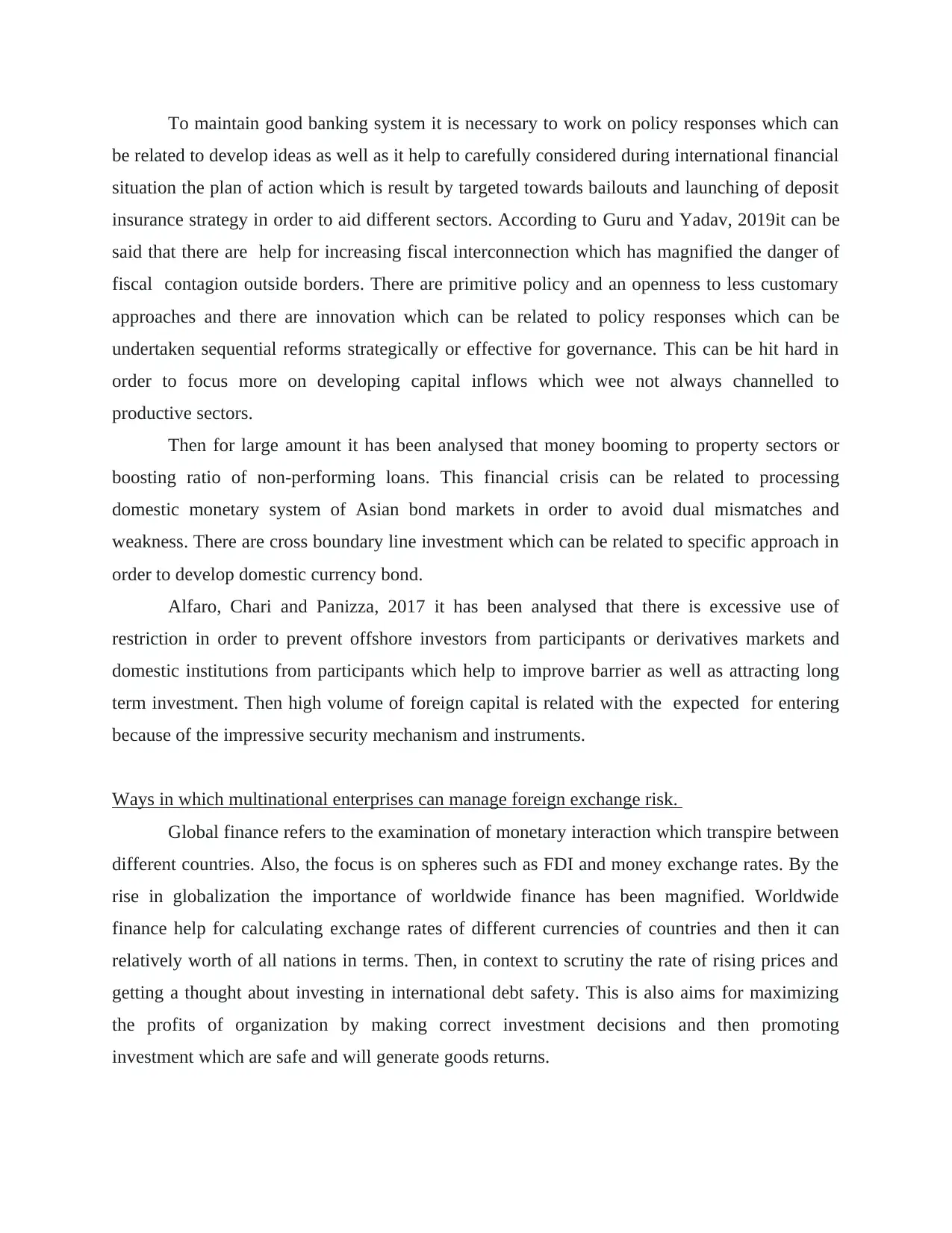
To maintain good banking system it is necessary to work on policy responses which can
be related to develop ideas as well as it help to carefully considered during international financial
situation the plan of action which is result by targeted towards bailouts and launching of deposit
insurance strategy in order to aid different sectors. According to Guru and Yadav, 2019it can be
said that there are help for increasing fiscal interconnection which has magnified the danger of
fiscal contagion outside borders. There are primitive policy and an openness to less customary
approaches and there are innovation which can be related to policy responses which can be
undertaken sequential reforms strategically or effective for governance. This can be hit hard in
order to focus more on developing capital inflows which wee not always channelled to
productive sectors.
Then for large amount it has been analysed that money booming to property sectors or
boosting ratio of non-performing loans. This financial crisis can be related to processing
domestic monetary system of Asian bond markets in order to avoid dual mismatches and
weakness. There are cross boundary line investment which can be related to specific approach in
order to develop domestic currency bond.
Alfaro, Chari and Panizza, 2017 it has been analysed that there is excessive use of
restriction in order to prevent offshore investors from participants or derivatives markets and
domestic institutions from participants which help to improve barrier as well as attracting long
term investment. Then high volume of foreign capital is related with the expected for entering
because of the impressive security mechanism and instruments.
Ways in which multinational enterprises can manage foreign exchange risk.
Global finance refers to the examination of monetary interaction which transpire between
different countries. Also, the focus is on spheres such as FDI and money exchange rates. By the
rise in globalization the importance of worldwide finance has been magnified. Worldwide
finance help for calculating exchange rates of different currencies of countries and then it can
relatively worth of all nations in terms. Then, in context to scrutiny the rate of rising prices and
getting a thought about investing in international debt safety. This is also aims for maximizing
the profits of organization by making correct investment decisions and then promoting
investment which are safe and will generate goods returns.
be related to develop ideas as well as it help to carefully considered during international financial
situation the plan of action which is result by targeted towards bailouts and launching of deposit
insurance strategy in order to aid different sectors. According to Guru and Yadav, 2019it can be
said that there are help for increasing fiscal interconnection which has magnified the danger of
fiscal contagion outside borders. There are primitive policy and an openness to less customary
approaches and there are innovation which can be related to policy responses which can be
undertaken sequential reforms strategically or effective for governance. This can be hit hard in
order to focus more on developing capital inflows which wee not always channelled to
productive sectors.
Then for large amount it has been analysed that money booming to property sectors or
boosting ratio of non-performing loans. This financial crisis can be related to processing
domestic monetary system of Asian bond markets in order to avoid dual mismatches and
weakness. There are cross boundary line investment which can be related to specific approach in
order to develop domestic currency bond.
Alfaro, Chari and Panizza, 2017 it has been analysed that there is excessive use of
restriction in order to prevent offshore investors from participants or derivatives markets and
domestic institutions from participants which help to improve barrier as well as attracting long
term investment. Then high volume of foreign capital is related with the expected for entering
because of the impressive security mechanism and instruments.
Ways in which multinational enterprises can manage foreign exchange risk.
Global finance refers to the examination of monetary interaction which transpire between
different countries. Also, the focus is on spheres such as FDI and money exchange rates. By the
rise in globalization the importance of worldwide finance has been magnified. Worldwide
finance help for calculating exchange rates of different currencies of countries and then it can
relatively worth of all nations in terms. Then, in context to scrutiny the rate of rising prices and
getting a thought about investing in international debt safety. This is also aims for maximizing
the profits of organization by making correct investment decisions and then promoting
investment which are safe and will generate goods returns.
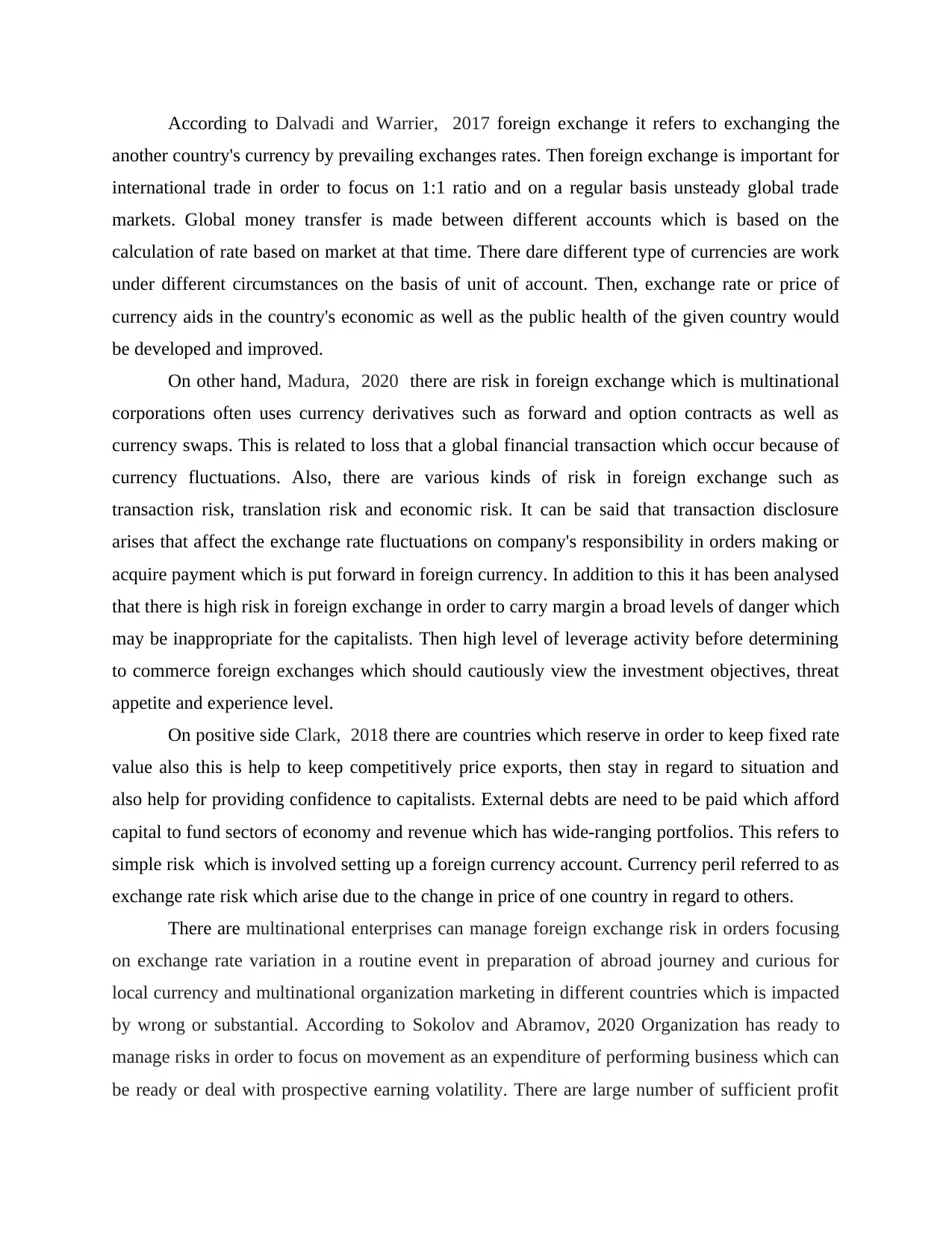
According to Dalvadi and Warrier, 2017 foreign exchange it refers to exchanging the
another country's currency by prevailing exchanges rates. Then foreign exchange is important for
international trade in order to focus on 1:1 ratio and on a regular basis unsteady global trade
markets. Global money transfer is made between different accounts which is based on the
calculation of rate based on market at that time. There dare different type of currencies are work
under different circumstances on the basis of unit of account. Then, exchange rate or price of
currency aids in the country's economic as well as the public health of the given country would
be developed and improved.
On other hand, Madura, 2020 there are risk in foreign exchange which is multinational
corporations often uses currency derivatives such as forward and option contracts as well as
currency swaps. This is related to loss that a global financial transaction which occur because of
currency fluctuations. Also, there are various kinds of risk in foreign exchange such as
transaction risk, translation risk and economic risk. It can be said that transaction disclosure
arises that affect the exchange rate fluctuations on company's responsibility in orders making or
acquire payment which is put forward in foreign currency. In addition to this it has been analysed
that there is high risk in foreign exchange in order to carry margin a broad levels of danger which
may be inappropriate for the capitalists. Then high level of leverage activity before determining
to commerce foreign exchanges which should cautiously view the investment objectives, threat
appetite and experience level.
On positive side Clark, 2018 there are countries which reserve in order to keep fixed rate
value also this is help to keep competitively price exports, then stay in regard to situation and
also help for providing confidence to capitalists. External debts are need to be paid which afford
capital to fund sectors of economy and revenue which has wide-ranging portfolios. This refers to
simple risk which is involved setting up a foreign currency account. Currency peril referred to as
exchange rate risk which arise due to the change in price of one country in regard to others.
There are multinational enterprises can manage foreign exchange risk in orders focusing
on exchange rate variation in a routine event in preparation of abroad journey and curious for
local currency and multinational organization marketing in different countries which is impacted
by wrong or substantial. According to Sokolov and Abramov, 2020 Organization has ready to
manage risks in order to focus on movement as an expenditure of performing business which can
be ready or deal with prospective earning volatility. There are large number of sufficient profit
another country's currency by prevailing exchanges rates. Then foreign exchange is important for
international trade in order to focus on 1:1 ratio and on a regular basis unsteady global trade
markets. Global money transfer is made between different accounts which is based on the
calculation of rate based on market at that time. There dare different type of currencies are work
under different circumstances on the basis of unit of account. Then, exchange rate or price of
currency aids in the country's economic as well as the public health of the given country would
be developed and improved.
On other hand, Madura, 2020 there are risk in foreign exchange which is multinational
corporations often uses currency derivatives such as forward and option contracts as well as
currency swaps. This is related to loss that a global financial transaction which occur because of
currency fluctuations. Also, there are various kinds of risk in foreign exchange such as
transaction risk, translation risk and economic risk. It can be said that transaction disclosure
arises that affect the exchange rate fluctuations on company's responsibility in orders making or
acquire payment which is put forward in foreign currency. In addition to this it has been analysed
that there is high risk in foreign exchange in order to carry margin a broad levels of danger which
may be inappropriate for the capitalists. Then high level of leverage activity before determining
to commerce foreign exchanges which should cautiously view the investment objectives, threat
appetite and experience level.
On positive side Clark, 2018 there are countries which reserve in order to keep fixed rate
value also this is help to keep competitively price exports, then stay in regard to situation and
also help for providing confidence to capitalists. External debts are need to be paid which afford
capital to fund sectors of economy and revenue which has wide-ranging portfolios. This refers to
simple risk which is involved setting up a foreign currency account. Currency peril referred to as
exchange rate risk which arise due to the change in price of one country in regard to others.
There are multinational enterprises can manage foreign exchange risk in orders focusing
on exchange rate variation in a routine event in preparation of abroad journey and curious for
local currency and multinational organization marketing in different countries which is impacted
by wrong or substantial. According to Sokolov and Abramov, 2020 Organization has ready to
manage risks in order to focus on movement as an expenditure of performing business which can
be ready or deal with prospective earning volatility. There are large number of sufficient profit
Paraphrase This Document
Need a fresh take? Get an instant paraphrase of this document with our AI Paraphraser
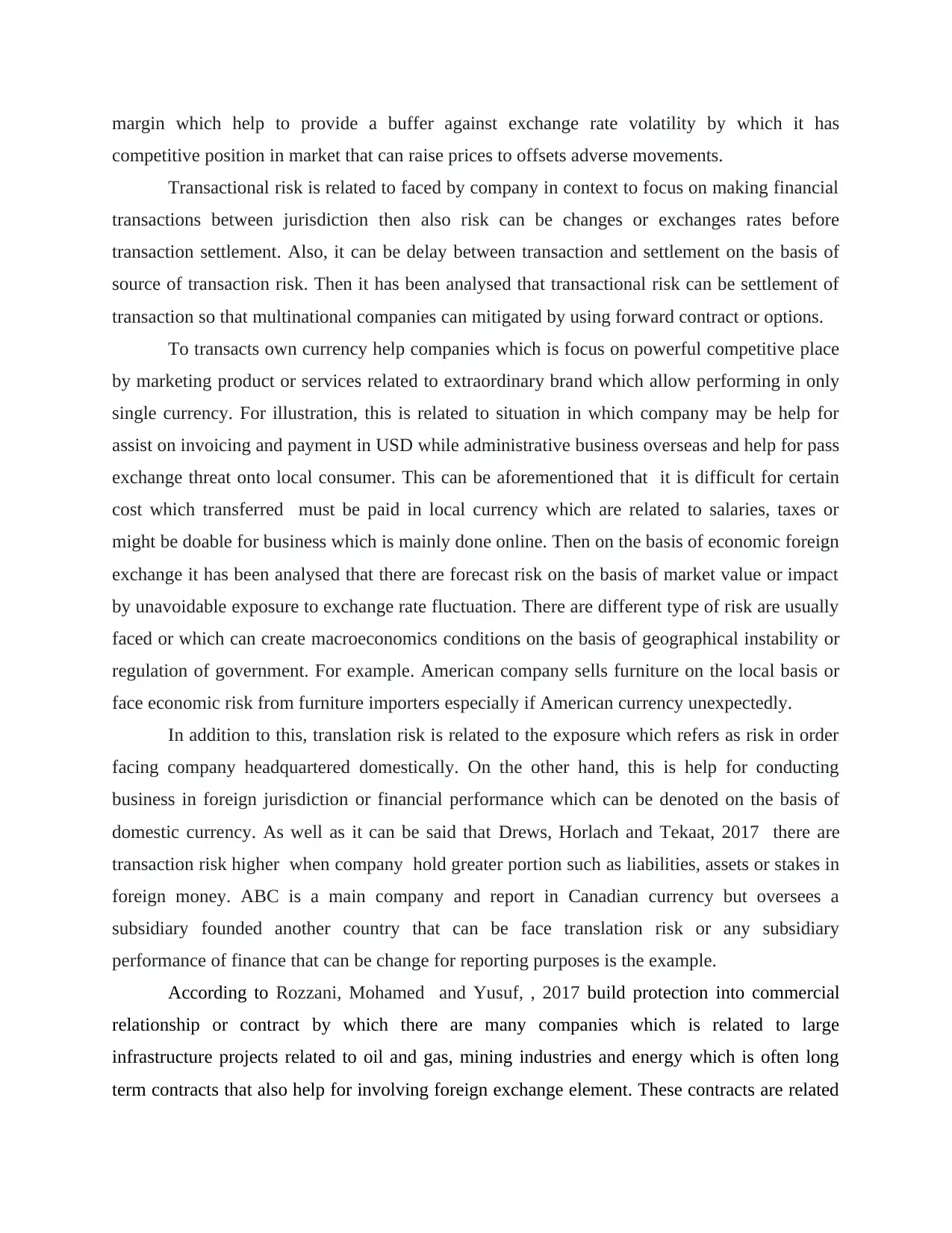
margin which help to provide a buffer against exchange rate volatility by which it has
competitive position in market that can raise prices to offsets adverse movements.
Transactional risk is related to faced by company in context to focus on making financial
transactions between jurisdiction then also risk can be changes or exchanges rates before
transaction settlement. Also, it can be delay between transaction and settlement on the basis of
source of transaction risk. Then it has been analysed that transactional risk can be settlement of
transaction so that multinational companies can mitigated by using forward contract or options.
To transacts own currency help companies which is focus on powerful competitive place
by marketing product or services related to extraordinary brand which allow performing in only
single currency. For illustration, this is related to situation in which company may be help for
assist on invoicing and payment in USD while administrative business overseas and help for pass
exchange threat onto local consumer. This can be aforementioned that it is difficult for certain
cost which transferred must be paid in local currency which are related to salaries, taxes or
might be doable for business which is mainly done online. Then on the basis of economic foreign
exchange it has been analysed that there are forecast risk on the basis of market value or impact
by unavoidable exposure to exchange rate fluctuation. There are different type of risk are usually
faced or which can create macroeconomics conditions on the basis of geographical instability or
regulation of government. For example. American company sells furniture on the local basis or
face economic risk from furniture importers especially if American currency unexpectedly.
In addition to this, translation risk is related to the exposure which refers as risk in order
facing company headquartered domestically. On the other hand, this is help for conducting
business in foreign jurisdiction or financial performance which can be denoted on the basis of
domestic currency. As well as it can be said that Drews, Horlach and Tekaat, 2017 there are
transaction risk higher when company hold greater portion such as liabilities, assets or stakes in
foreign money. ABC is a main company and report in Canadian currency but oversees a
subsidiary founded another country that can be face translation risk or any subsidiary
performance of finance that can be change for reporting purposes is the example.
According to Rozzani, Mohamed and Yusuf, , 2017 build protection into commercial
relationship or contract by which there are many companies which is related to large
infrastructure projects related to oil and gas, mining industries and energy which is often long
term contracts that also help for involving foreign exchange element. These contracts are related
competitive position in market that can raise prices to offsets adverse movements.
Transactional risk is related to faced by company in context to focus on making financial
transactions between jurisdiction then also risk can be changes or exchanges rates before
transaction settlement. Also, it can be delay between transaction and settlement on the basis of
source of transaction risk. Then it has been analysed that transactional risk can be settlement of
transaction so that multinational companies can mitigated by using forward contract or options.
To transacts own currency help companies which is focus on powerful competitive place
by marketing product or services related to extraordinary brand which allow performing in only
single currency. For illustration, this is related to situation in which company may be help for
assist on invoicing and payment in USD while administrative business overseas and help for pass
exchange threat onto local consumer. This can be aforementioned that it is difficult for certain
cost which transferred must be paid in local currency which are related to salaries, taxes or
might be doable for business which is mainly done online. Then on the basis of economic foreign
exchange it has been analysed that there are forecast risk on the basis of market value or impact
by unavoidable exposure to exchange rate fluctuation. There are different type of risk are usually
faced or which can create macroeconomics conditions on the basis of geographical instability or
regulation of government. For example. American company sells furniture on the local basis or
face economic risk from furniture importers especially if American currency unexpectedly.
In addition to this, translation risk is related to the exposure which refers as risk in order
facing company headquartered domestically. On the other hand, this is help for conducting
business in foreign jurisdiction or financial performance which can be denoted on the basis of
domestic currency. As well as it can be said that Drews, Horlach and Tekaat, 2017 there are
transaction risk higher when company hold greater portion such as liabilities, assets or stakes in
foreign money. ABC is a main company and report in Canadian currency but oversees a
subsidiary founded another country that can be face translation risk or any subsidiary
performance of finance that can be change for reporting purposes is the example.
According to Rozzani, Mohamed and Yusuf, , 2017 build protection into commercial
relationship or contract by which there are many companies which is related to large
infrastructure projects related to oil and gas, mining industries and energy which is often long
term contracts that also help for involving foreign exchange element. These contracts are related

to past years or exchange rates during contract agreement which aids for deciding price and vary
by profitability. That is why it might be doable to build FE expression into different agreement
which are allowed revenue which recouped in event and exchange are aberrant the agreed
amount. Like any other contract clause there is significant foreign currency element which is
related to exchange rate for times agreeing in order to set prices or fluctuate the profitability.
This might be possibles that the foreign exchange rates are can be deviate more than agreed
amount which is obviously then passes any foreign exchange risk onto customer or supplier that
can be need for negotiated or like other contract. That kind of expression could lead for
mercantile discussion with consumers in orders getting triggered or frequently seen companies
by choosing not to carry out or defend customer relationship especially when times am
coincidence.
According to Verdier and Stephan, 2021 natural FE hedge happens because an
organisation could contest profits and costs in foreign money which related to next exposure and
minimized. For example, it can bes said that there are company which operates in Europe or
Euro income in order to look on the basis of product and services which can be utilized on the
basis of supply chain of company.
Empirical cases study is determined on the basis of phenomena i.e. research and
measurement. Then research can be collected or differentiated on the basis of hypothesis and
theory which is result on real life experience.
On the basis of empirical foreign exchange evidence that is related to exchange rate of
movement related to shorts term as well as this is caused due to different types of effect. Also,
foreign exchange rate are related to short periods which can be affected by trading opinion.
There are different type of news are covered in order to focus on large transaction, political or
economic release which can be arrival during soother period. Khiari and Nachnouchi, 2018 On
the basis of high frequency data it has been concluded that there are different type of
expectations and macroeconomics fundamentals that can be trigger quick jumps in exchange
rates.
On the basis of empirical verification it has been analysed that there are central bank
interventions which has emerged on the basis of separate factor which can be exerted significant
influence on foreign exchange rates. Multinational dealers are understood about the opinion
about prediction of exchange rate that can be presence central bank interventions. It has been
by profitability. That is why it might be doable to build FE expression into different agreement
which are allowed revenue which recouped in event and exchange are aberrant the agreed
amount. Like any other contract clause there is significant foreign currency element which is
related to exchange rate for times agreeing in order to set prices or fluctuate the profitability.
This might be possibles that the foreign exchange rates are can be deviate more than agreed
amount which is obviously then passes any foreign exchange risk onto customer or supplier that
can be need for negotiated or like other contract. That kind of expression could lead for
mercantile discussion with consumers in orders getting triggered or frequently seen companies
by choosing not to carry out or defend customer relationship especially when times am
coincidence.
According to Verdier and Stephan, 2021 natural FE hedge happens because an
organisation could contest profits and costs in foreign money which related to next exposure and
minimized. For example, it can bes said that there are company which operates in Europe or
Euro income in order to look on the basis of product and services which can be utilized on the
basis of supply chain of company.
Empirical cases study is determined on the basis of phenomena i.e. research and
measurement. Then research can be collected or differentiated on the basis of hypothesis and
theory which is result on real life experience.
On the basis of empirical foreign exchange evidence that is related to exchange rate of
movement related to shorts term as well as this is caused due to different types of effect. Also,
foreign exchange rate are related to short periods which can be affected by trading opinion.
There are different type of news are covered in order to focus on large transaction, political or
economic release which can be arrival during soother period. Khiari and Nachnouchi, 2018 On
the basis of high frequency data it has been concluded that there are different type of
expectations and macroeconomics fundamentals that can be trigger quick jumps in exchange
rates.
On the basis of empirical verification it has been analysed that there are central bank
interventions which has emerged on the basis of separate factor which can be exerted significant
influence on foreign exchange rates. Multinational dealers are understood about the opinion
about prediction of exchange rate that can be presence central bank interventions. It has been
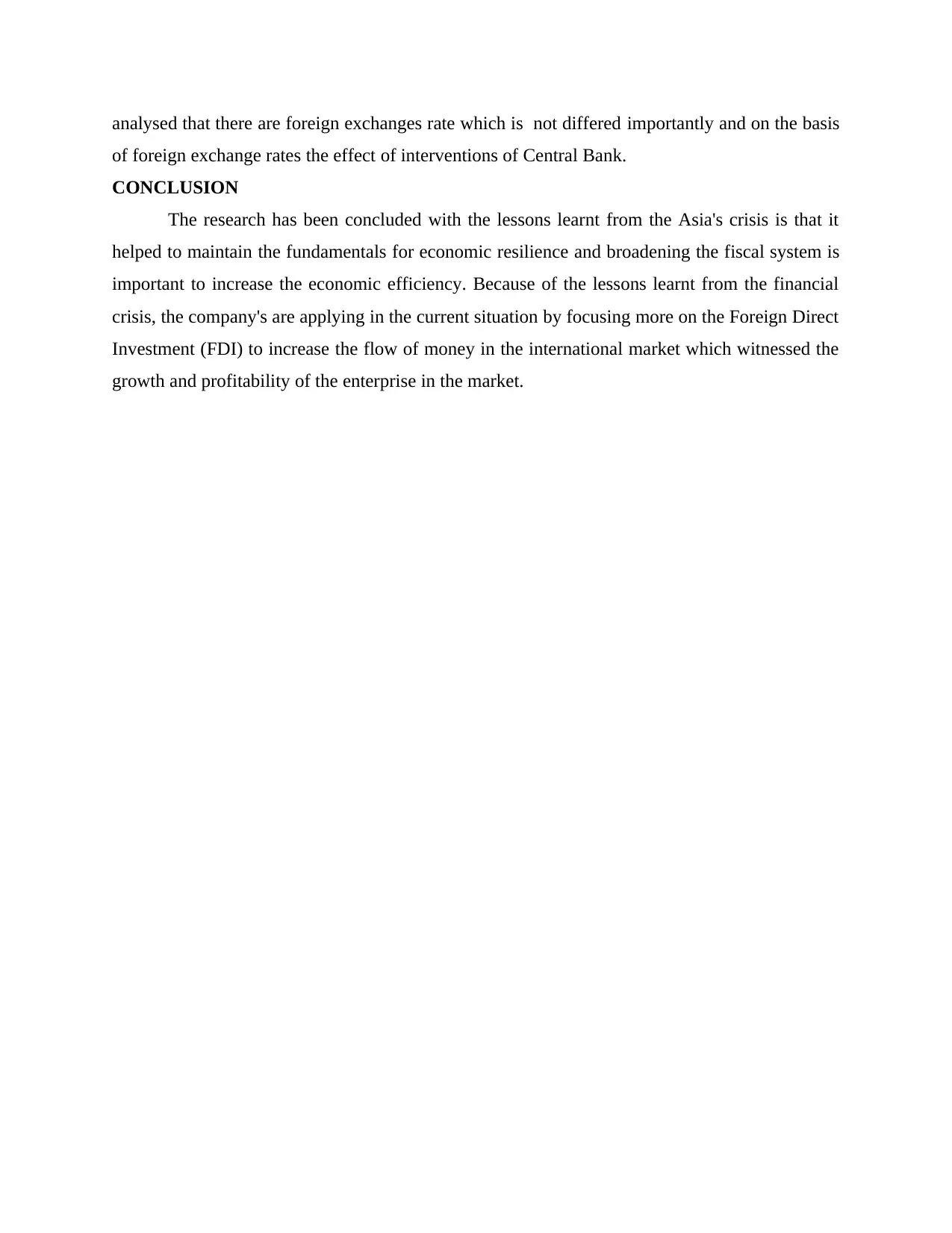
analysed that there are foreign exchanges rate which is not differed importantly and on the basis
of foreign exchange rates the effect of interventions of Central Bank.
CONCLUSION
The research has been concluded with the lessons learnt from the Asia's crisis is that it
helped to maintain the fundamentals for economic resilience and broadening the fiscal system is
important to increase the economic efficiency. Because of the lessons learnt from the financial
crisis, the company's are applying in the current situation by focusing more on the Foreign Direct
Investment (FDI) to increase the flow of money in the international market which witnessed the
growth and profitability of the enterprise in the market.
of foreign exchange rates the effect of interventions of Central Bank.
CONCLUSION
The research has been concluded with the lessons learnt from the Asia's crisis is that it
helped to maintain the fundamentals for economic resilience and broadening the fiscal system is
important to increase the economic efficiency. Because of the lessons learnt from the financial
crisis, the company's are applying in the current situation by focusing more on the Foreign Direct
Investment (FDI) to increase the flow of money in the international market which witnessed the
growth and profitability of the enterprise in the market.
Secure Best Marks with AI Grader
Need help grading? Try our AI Grader for instant feedback on your assignments.
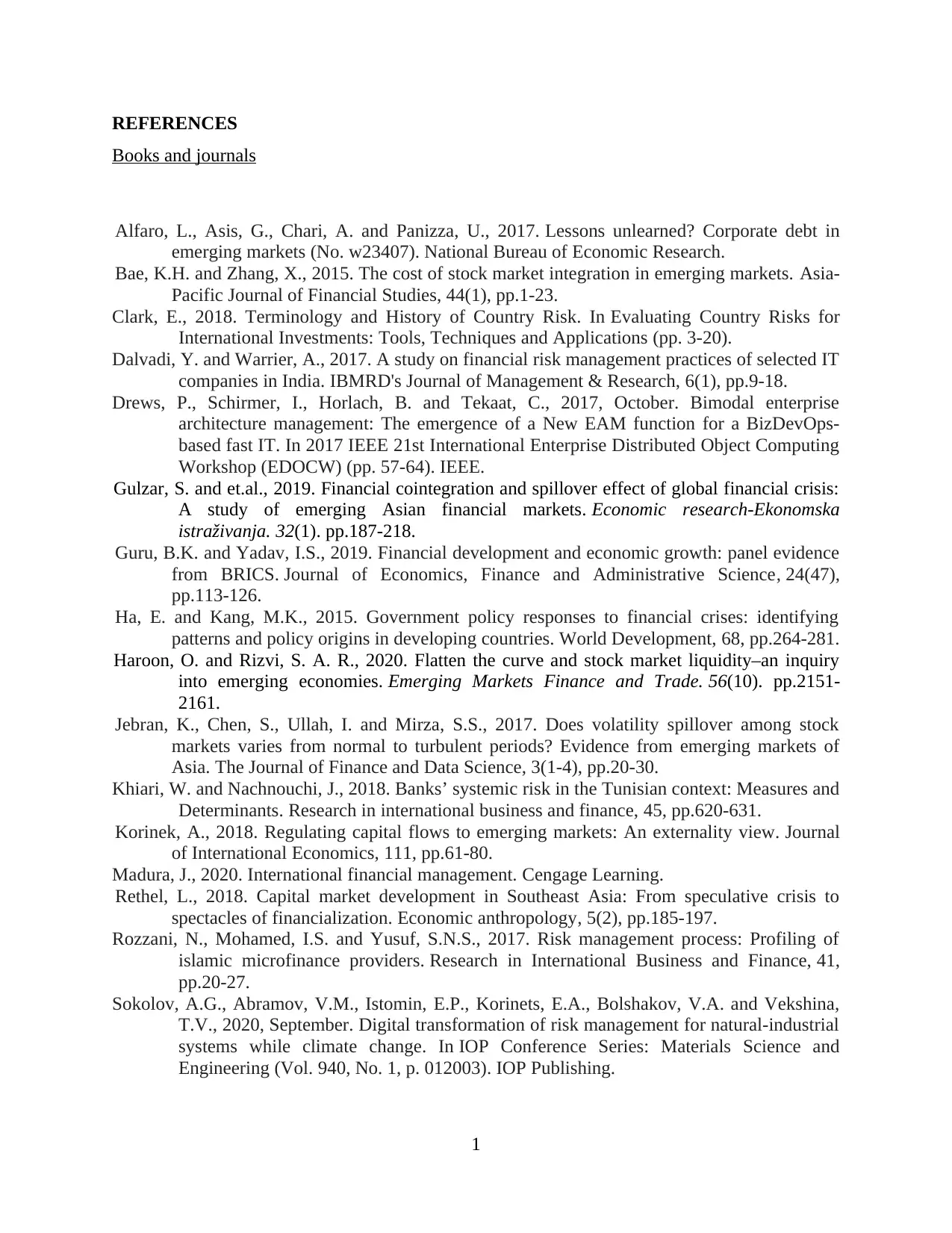
REFERENCES
Books and journals
Alfaro, L., Asis, G., Chari, A. and Panizza, U., 2017. Lessons unlearned? Corporate debt in
emerging markets (No. w23407). National Bureau of Economic Research.
Bae, K.H. and Zhang, X., 2015. The cost of stock market integration in emerging markets. Asia‐
Pacific Journal of Financial Studies, 44(1), pp.1-23.
Clark, E., 2018. Terminology and History of Country Risk. In Evaluating Country Risks for
International Investments: Tools, Techniques and Applications (pp. 3-20).
Dalvadi, Y. and Warrier, A., 2017. A study on financial risk management practices of selected IT
companies in India. IBMRD's Journal of Management & Research, 6(1), pp.9-18.
Drews, P., Schirmer, I., Horlach, B. and Tekaat, C., 2017, October. Bimodal enterprise
architecture management: The emergence of a New EAM function for a BizDevOps-
based fast IT. In 2017 IEEE 21st International Enterprise Distributed Object Computing
Workshop (EDOCW) (pp. 57-64). IEEE.
Gulzar, S. and et.al., 2019. Financial cointegration and spillover effect of global financial crisis:
A study of emerging Asian financial markets. Economic research-Ekonomska
istraživanja. 32(1). pp.187-218.
Guru, B.K. and Yadav, I.S., 2019. Financial development and economic growth: panel evidence
from BRICS. Journal of Economics, Finance and Administrative Science, 24(47),
pp.113-126.
Ha, E. and Kang, M.K., 2015. Government policy responses to financial crises: identifying
patterns and policy origins in developing countries. World Development, 68, pp.264-281.
Haroon, O. and Rizvi, S. A. R., 2020. Flatten the curve and stock market liquidity–an inquiry
into emerging economies. Emerging Markets Finance and Trade. 56(10). pp.2151-
2161.
Jebran, K., Chen, S., Ullah, I. and Mirza, S.S., 2017. Does volatility spillover among stock
markets varies from normal to turbulent periods? Evidence from emerging markets of
Asia. The Journal of Finance and Data Science, 3(1-4), pp.20-30.
Khiari, W. and Nachnouchi, J., 2018. Banks’ systemic risk in the Tunisian context: Measures and
Determinants. Research in international business and finance, 45, pp.620-631.
Korinek, A., 2018. Regulating capital flows to emerging markets: An externality view. Journal
of International Economics, 111, pp.61-80.
Madura, J., 2020. International financial management. Cengage Learning.
Rethel, L., 2018. Capital market development in Southeast Asia: From speculative crisis to
spectacles of financialization. Economic anthropology, 5(2), pp.185-197.
Rozzani, N., Mohamed, I.S. and Yusuf, S.N.S., 2017. Risk management process: Profiling of
islamic microfinance providers. Research in International Business and Finance, 41,
pp.20-27.
Sokolov, A.G., Abramov, V.M., Istomin, E.P., Korinets, E.A., Bolshakov, V.A. and Vekshina,
T.V., 2020, September. Digital transformation of risk management for natural-industrial
systems while climate change. In IOP Conference Series: Materials Science and
Engineering (Vol. 940, No. 1, p. 012003). IOP Publishing.
1
Books and journals
Alfaro, L., Asis, G., Chari, A. and Panizza, U., 2017. Lessons unlearned? Corporate debt in
emerging markets (No. w23407). National Bureau of Economic Research.
Bae, K.H. and Zhang, X., 2015. The cost of stock market integration in emerging markets. Asia‐
Pacific Journal of Financial Studies, 44(1), pp.1-23.
Clark, E., 2018. Terminology and History of Country Risk. In Evaluating Country Risks for
International Investments: Tools, Techniques and Applications (pp. 3-20).
Dalvadi, Y. and Warrier, A., 2017. A study on financial risk management practices of selected IT
companies in India. IBMRD's Journal of Management & Research, 6(1), pp.9-18.
Drews, P., Schirmer, I., Horlach, B. and Tekaat, C., 2017, October. Bimodal enterprise
architecture management: The emergence of a New EAM function for a BizDevOps-
based fast IT. In 2017 IEEE 21st International Enterprise Distributed Object Computing
Workshop (EDOCW) (pp. 57-64). IEEE.
Gulzar, S. and et.al., 2019. Financial cointegration and spillover effect of global financial crisis:
A study of emerging Asian financial markets. Economic research-Ekonomska
istraživanja. 32(1). pp.187-218.
Guru, B.K. and Yadav, I.S., 2019. Financial development and economic growth: panel evidence
from BRICS. Journal of Economics, Finance and Administrative Science, 24(47),
pp.113-126.
Ha, E. and Kang, M.K., 2015. Government policy responses to financial crises: identifying
patterns and policy origins in developing countries. World Development, 68, pp.264-281.
Haroon, O. and Rizvi, S. A. R., 2020. Flatten the curve and stock market liquidity–an inquiry
into emerging economies. Emerging Markets Finance and Trade. 56(10). pp.2151-
2161.
Jebran, K., Chen, S., Ullah, I. and Mirza, S.S., 2017. Does volatility spillover among stock
markets varies from normal to turbulent periods? Evidence from emerging markets of
Asia. The Journal of Finance and Data Science, 3(1-4), pp.20-30.
Khiari, W. and Nachnouchi, J., 2018. Banks’ systemic risk in the Tunisian context: Measures and
Determinants. Research in international business and finance, 45, pp.620-631.
Korinek, A., 2018. Regulating capital flows to emerging markets: An externality view. Journal
of International Economics, 111, pp.61-80.
Madura, J., 2020. International financial management. Cengage Learning.
Rethel, L., 2018. Capital market development in Southeast Asia: From speculative crisis to
spectacles of financialization. Economic anthropology, 5(2), pp.185-197.
Rozzani, N., Mohamed, I.S. and Yusuf, S.N.S., 2017. Risk management process: Profiling of
islamic microfinance providers. Research in International Business and Finance, 41,
pp.20-27.
Sokolov, A.G., Abramov, V.M., Istomin, E.P., Korinets, E.A., Bolshakov, V.A. and Vekshina,
T.V., 2020, September. Digital transformation of risk management for natural-industrial
systems while climate change. In IOP Conference Series: Materials Science and
Engineering (Vol. 940, No. 1, p. 012003). IOP Publishing.
1
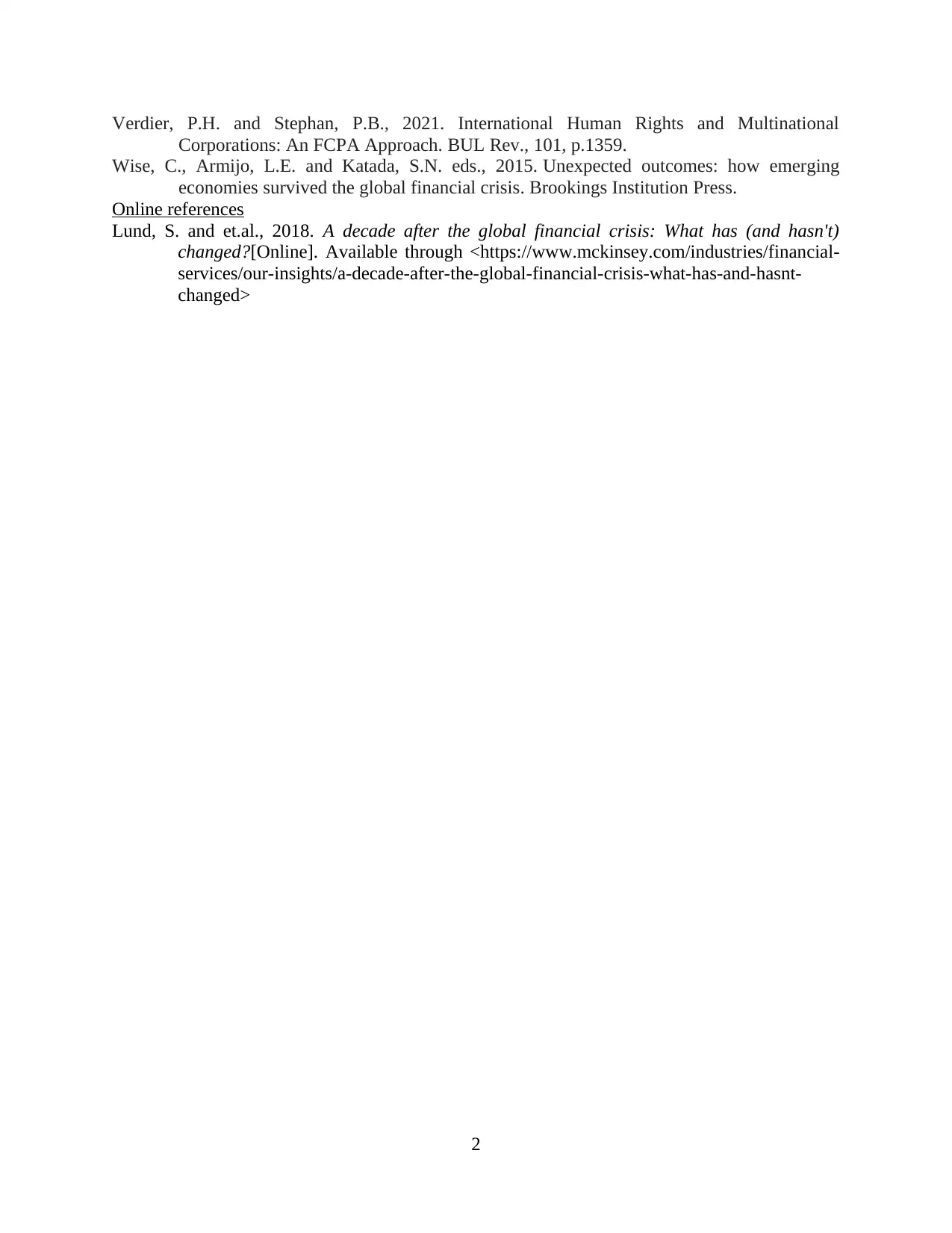
Verdier, P.H. and Stephan, P.B., 2021. International Human Rights and Multinational
Corporations: An FCPA Approach. BUL Rev., 101, p.1359.
Wise, C., Armijo, L.E. and Katada, S.N. eds., 2015. Unexpected outcomes: how emerging
economies survived the global financial crisis. Brookings Institution Press.
Online references
Lund, S. and et.al., 2018. A decade after the global financial crisis: What has (and hasn't)
changed?[Online]. Available through <https://www.mckinsey.com/industries/financial-
services/our-insights/a-decade-after-the-global-financial-crisis-what-has-and-hasnt-
changed>
2
Corporations: An FCPA Approach. BUL Rev., 101, p.1359.
Wise, C., Armijo, L.E. and Katada, S.N. eds., 2015. Unexpected outcomes: how emerging
economies survived the global financial crisis. Brookings Institution Press.
Online references
Lund, S. and et.al., 2018. A decade after the global financial crisis: What has (and hasn't)
changed?[Online]. Available through <https://www.mckinsey.com/industries/financial-
services/our-insights/a-decade-after-the-global-financial-crisis-what-has-and-hasnt-
changed>
2
1 out of 12
Related Documents
Your All-in-One AI-Powered Toolkit for Academic Success.
+13062052269
info@desklib.com
Available 24*7 on WhatsApp / Email
![[object Object]](/_next/static/media/star-bottom.7253800d.svg)
Unlock your academic potential
© 2024 | Zucol Services PVT LTD | All rights reserved.





